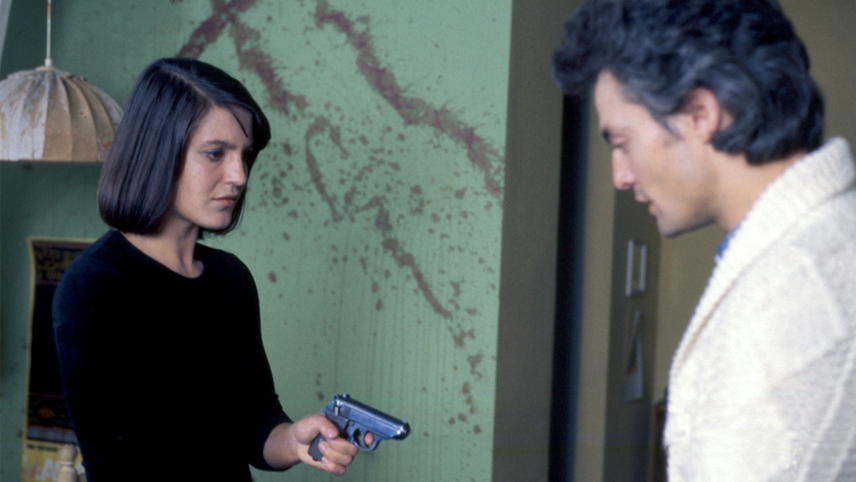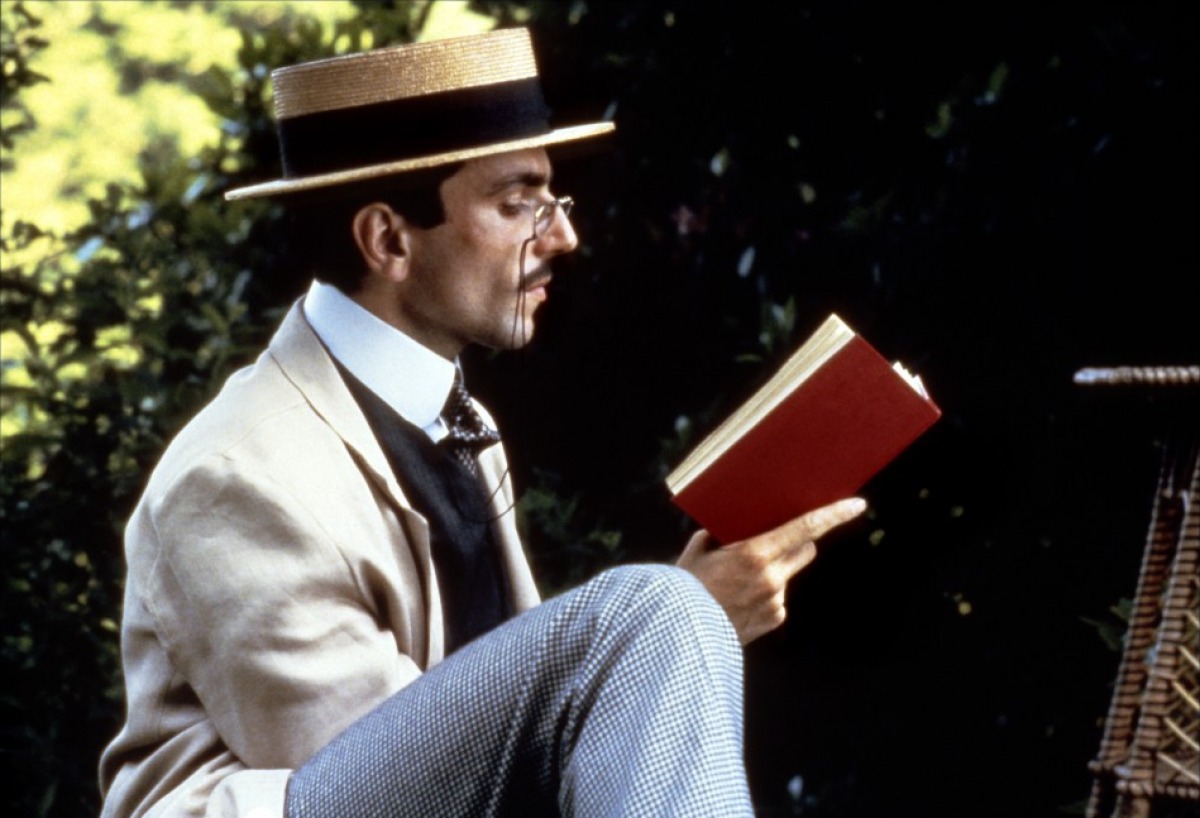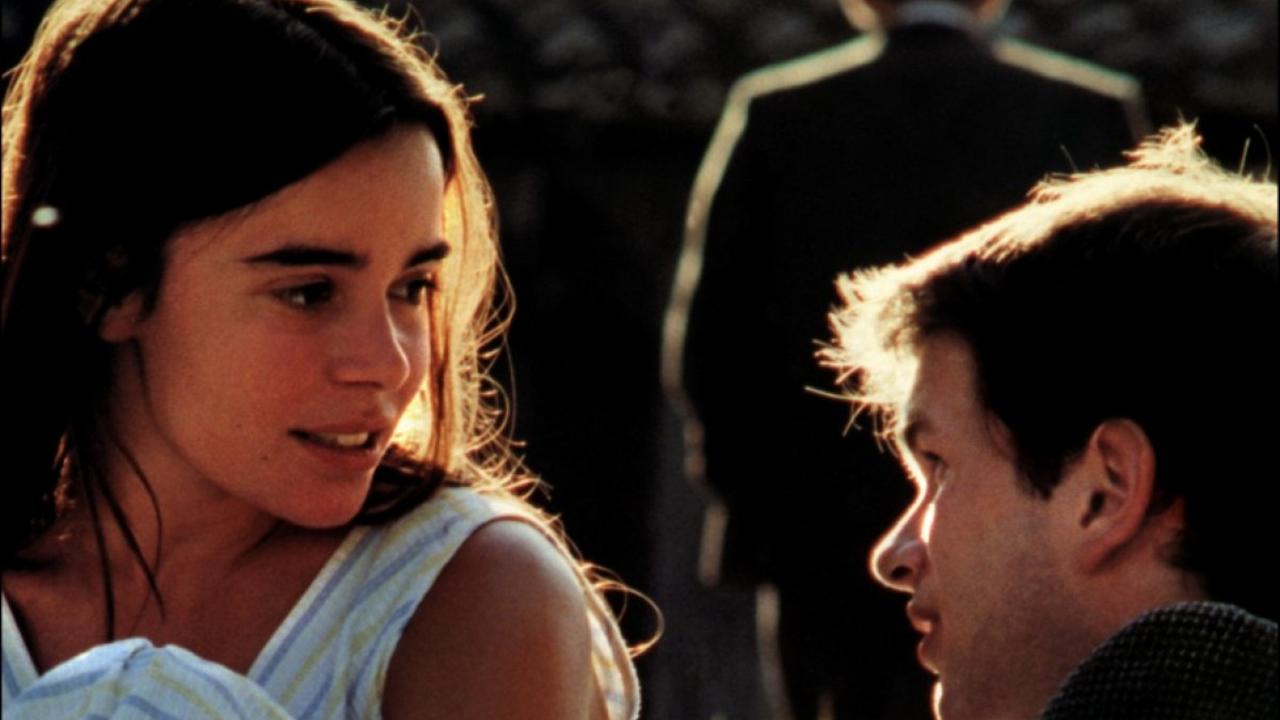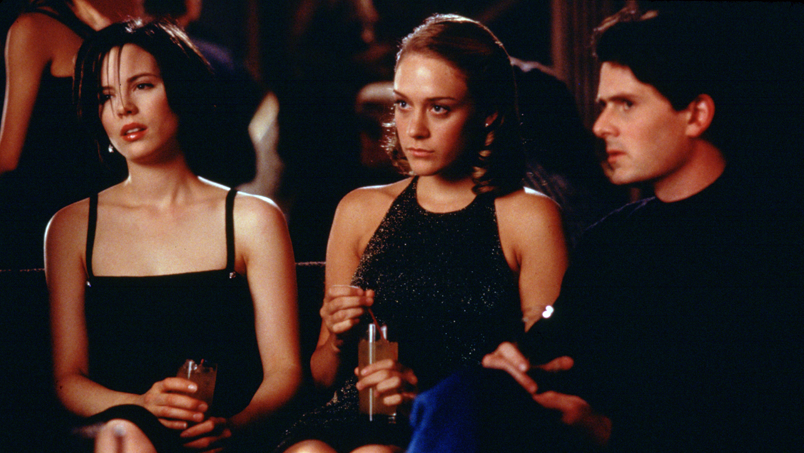6. The Lost Honor of Katharina Blum (1975)

As time goes by, film is increasingly regarded as a director’s medium, with the director being an “auteur” or nothing at all. This may help to explain why the fine (West) German film “The Lost Honor of Katharina Blum” is now a bit overlooked. It has two collaborating directors credited!
One is the Oscar-winning Volker Schlondorff (1980’s unforgettable “The Tin Drum”) and the other, the less awarded but highly regarded Margaretha Von Trotta (1975’s “Coup de Grace”). The way ardent film students look at it, this was one auteur too many. It also doesn’t help that the plot of the film feels very specific to its country of origin (as the US TV network CBS found out a short time after the original came out, when it broadcast a surprising remake starring former sitcom star Marlo Thomas with Kris Kristofferson in a version that felt just plain wrong).
The plot revolves around the title character (Angela Winkler), an average type who picks up an attractive man (German star Jurgen Prochnow in a short but compelling turn) and takes him home for a blissful sexual evening. Too bad it’s all cut short the next morning when the police break into Katharina’s apartment looking for the now long departed man. It seems that he is a political terrorist on the run from them, and he took up with the woman either as a brief respite or as a smoke screen in order to get away.
In any event, he has left Katharina to face the police, who don’t want to believe that the woman had a simple chance encounter with the man. Just as bad, the press, with no terrorist to sensationalize, decides to twist the woman into as many headlines as she’s worth, managing to trash her life most effectively, causing her to take a harsh course of action.
The world has turned a few times since this film came out. The then-country of West Germany is now part of a reunified Germany and the political climate is somewhat different. This film may now well be a period piece. However, it has good performances and is well put together, regardless of how many people put it together. It deserves to be less lost than Katharina’s honor.
7. A Room with a View (1985)

Bringing up the longtime filmmaking team of US-born director James Ivory and his longtime creative and life partner Indian native Ismail Merchant (and, somewhat, their frequent writer, German-born Ruth Prawer Jhabvala) is a somewhat dicey proposition for the art house lover. Though the team dissolved with the death of Merchant in 2005 (more or less ending the cinematic careers of the other two), the memories of Merchant-Ivory films still somewhat haunts the cinema art circuit.
When the two first got together it was in Merchant’s native country in the 1960s, where they created a number of films mostly concerning the intersection of native Indian life with that of Western newcomers to the landscape (of which there were many in that era). This led to the misconception that both men were Indian.
Perhaps to combat that idea, they switched from Indian themes, which did possess a spark of life amid the pair’s inherent tastefulness, to adaptations of classic literature. This was where things started to get dicey with bloodless versions of the way, way subtle books of US author Henry James (1984’s “The Bostonians” is as bad an example as any, despite a brilliant performance from Vanessa Redgrave).
It became a joke among the knowing that the kind of people who claimed to love Merchant Ivory films were the same sorts who bragged about only turning on television to watch the British shows on PBS. However, though their track record remained uneven to their last film, they thankfully branched out into other authors (and their post-Indian films were always literary adaptations) and found their best prose muse in the works of early 20th century author E.M. Forster (which, amazingly, were almost untouched by the movies).
Though their best effort was surely 1992’s Howards End (probably their best film period), their first Forster foray was the slight, charming “A Room with a View.” Set at the beginning of the 20th century, the story follows Lucy Honeychurch (then-newcomer Helena Bonham-Carter, coming off as period as ever), a young lady of good family who is sent with a chaperone (a wonderfully funny Maggie Smith as a poor relative who keeps making sure that everyone knows that she knows her lowly place) on a trip to Italy before her marriage to one of the most conventionally boring men in Edwardian England (a young Daniel Day-Lewis, brilliant even then).
While there, a number of events combine to cause Lucy to meet and fall in love with George Emerson (Julian Sands). The young man and his widowed father (British stalwart Denholm Elliott in one of his most memorable performances) lead as natural, free and uninhibited a life as one can in the England of the day, one that looks way more appealing than Lucy’s alternative destiny. Could it be that Lucy might flaunt convention for love?
The happy surprise here is that all of the elements in the team’s previous films which smacked of the worst of TV’s “Masterpiece Theatre” are avoided. The cinematography makes the lovely costumes and sets light up. The large cast of familiar or soon-to-be-familiar faces (Judi Dench, Simon Callow, Fabia Drake and Rupert Everett, among them) shine instead of giving the rote performances that might have resulted from the types of roles which they had played so often.
This film did for Merchant Ivory basically what George ends up doing for Lucy, liberating the concerned parties. It received a good handful of Oscar nominations (including much-deserved ones for Smith and Elliott). It’s too bad that better-known and more substantial Merchant Ivory efforts caused this one to be swept aside a bit. It’s still a small treasure.
8. Wild Reeds (1994)

LGBT films exist in a niche that gives them (if they’re known at all) a certain loyal audience but often little more. This French coming-of-age drama is confined to this niche. The irony is that, while it does have some gay content, it’s a sensitive and knowing coming-of-age story above all. However, it takes so little to tar with some brushes.
The setting is a village in the southern part of France in 1962, during the time of the Algerian war. An 18-year-old boy named Francois (Gael Morel) has come to attend school and forms a friendship with classmate Maite (Elodie Bouchez), which could turn into love but hasn’t.
Another classmate is the handsome and brooding Serge (Stephane Rideau), who loves the woman his older brother has just married in order to avoid going to the war. Francois is surprised to find himself attracted to the unhappy Serge, who, also surprisingly, responds to this affection in a troubled moment. The catalyst in the mix is the arrival of a young French student born in Algeria, Henri (Frederic Gorny), whose blunt honesty brings a reckoning to the other three characters.
Over the course of the story, it turns out that only Francois is truly gay, with Serge being curious and confused. The two end matters with sad civility and a most believable conversation after an upsetting confrontation. They and their friends are all growing up to face and find the lives they wish to pursue.
Director Andre Techine was/is a longtime staple of French cinema, but the short patch of time surrounding the release of this film was his most memorable by far. Just prior to this was 1993’s” My Favorite Season” and just after, 1996’s “Les Voleurs.” Both became more mainstream art house favorites. However, when the final reckoning comes, this one may stand as his most passionate and heartfelt.
9. The Last Days of Disco (1998)

Late adolescence must have hit the highly literate and classy writer-director Whit Stillman pretty hard. That or he really loved it and, thus, kept revisiting it in his first films. His debut, 1990’s “Metropolitan” and his follow-up, the underseen “Barcelona” from 1994, both dealt with young people of a certain social class finishing up at Ivy League schools and finding that they are unsure of what to do next (but, unlike Benjamin Braddock from 1967’s “The Graduate,” they don’t do anything nearly as titillating as having an affair with Mrs. Robinson). Why should it have come as any surprise at all that this basic outline was also the plot for film number three, “The Last Days of Disco.”
One of the marks of a true artist is that they can take the same basic elements of their work (elements with some profound personal meaning, preferably) and wring enough meaningful changes from one project to the next and still keep it all pertinent. Stillman is able to do this quite well. One big factor is that each film is set in a different, offbeat, yet well-defined era and milieu (and “Barcelona” has that in spades, if nothing else). Secondly, the characters may all come from the same societal place, but they are far from being the same cookie-cutter pattern designs.
“The Last Days of Disco” comes as advertised and is set in the early 1980’s (only a few years earlier than the production date and a time Whitman knew well). The plot is tangled, but only because the young lives on which it focuses are as well. Well-educated but poorly paid publishing house slaves Alice (Chloe Sevigny, an actress just born to be in a Stillman film) and Charlotte (Kate Beckinsale, right on the money as well) want to climb up from being mere readers to the big time and/or meet Mr. Right.
Both goals somehow seem tied to the fading disco club scene and the men they meet there (Mackenzie Astin, Robert Sean Leonard, Matt Keeslar and Chris Eigeman are among them). There will commence one night stands, career mishaps and triumphs (to some degree), STDs and heartbreak, and lots of worry about paying for everything while trying to keep looking poised and attractive.
This sounds flip but, in all honesty, it plays much like how a fine novel reads. Indeed, Stillman later novelized it and won a prestigious literary prize! This may give a clue as to why this, and all other Stillman films, seem to get overlooked. One must pay attention and think about them a bit.
Fans of Ingmar Bergman and Michelangelo Antonioni may be prepared to do that when seeing one of those director’s films, but the average viewer seeing something such as this in a Cineplex might well balk. Yes, this and other Stillman works are a bit rarified, but that just shows how special they are and remain.
10. Happiness/Life in Wartime (1998/2009)

While looking over the work of writer-director Todd Solondz, one can’t help but wonder if he doesn’t live to upset people. Maybe he’s upset and wants to share it. If his films truly reflect his worldview, this is not at all a far-fetched theory.
Even his recent film, 2016’s “Wiener-Dog,” seems initially to be one of those warm-hearted family films about a pet… but don’t be fooled! However, the height, or nadir, depending on one’s attitude, of his work is the ultra-controversial family saga he unleashed in 1998 and the little-seen (and understood) quasi-sequel he released a decade later.
“Happiness” was so upsetting to its original intended releasing company that its production company had to go into the releasing business in order to make sure that it would be seen. The story, with a number of sub-plots, deals with the lives of three sisters, Trish (Cynthia Stevenson), Helen (Lara Flynn Boyle) and Joy (Jane Adams).
Joy (and if that name isn’t an irony, there never was one in Solondz’ work) is by far the nicest, but her life is misshapen. She works in a call center and is also trying to get a teaching career off the ground, instructing immigrants in English at a night school (a scab job she took from a striking teacher). At the film’s opening, she breaks off with her obnoxious boyfriend Andy (Jon Lovitz), who then denounces her and then proceeds to go home and kill himself. Things proceed to go downhill from there (!) as she ill-advisedly gets involved with a married student.
Helen is a successful writer, but feels only self-contempt since she knows that she is only an empty hack, leading her to offer an assignation to accountant/obscene phone caller Allen (Philip Seymour Hoffman, showing why he’s much lamented).
Trish thinks her married family life is perfect, but little does she know that her psychiatrist husband, Bill (Dylan Baker in a brave and excellent performance), is gay. This would be distressing enough, but he really, really likes ’em young, to the point where he drugs everyone in the house whenever his 14-year-old son Billy has a sleepover guest and routinely rapes the underage guests.
Add in the sister’s emotionally numb parents, a portly neighbor (Camryn Manheim) who killed the doorman who tried to rape her and put his cut up body in the freezer (and who keeps interrupting her intense confession in a restaurant to cheerfully order one dessert after another), and then young Billy, who is put out that dad didn’t want to rape him as well. No wonder many found this film disturbing. (And a straightfaced scene where one of the rape victims insists he didn’t mind while his parents express outrage to the police doesn’t help.)
Though the film had its critical and cult fans, the idea of a sequel didn’t even seem plausible, but Solondz delivered quite a surprise with “Life During Wartime,” a sort-of sequel which picks up the family’s life 10 years later.
Trish and her brood are still trying to pick up the pieces (she along with the father of the main character from Solondz’ 1997 debut film, “Welcome to the Dollhouse,” a man she keeps desperately proclaiming is normal). Bill is about to get out of prison and is trying to find his family in hiding, especially college student Billy. Joy is married to a sadly unreformed Allen (maliciously matchmade by Helen), and is seeing visions of Andy. Lots more misery and misunderstanding abound.
One big reason that the filmmaker created this film was to advance his theories about film characters in relation to the actors playing them, an idea he had first put forward in “Palindromes” in 2004 (a film with some queasy content as well). To that end, no one from the first film repeats their roles and some of the recasts are jarring (Hoffman is replaced by African-American actor Michael K. Williams, Lovitz by Paul “Pee-wee Herman” Reubens, and British actor Ciaran Hinds as Bill, with Allison Janney, Shirley Henderson, Ally Sheedy and Charlotte Rampling filling out the cast).
Then again, the action of the film plays out pretty jarringly, too. In the end, “Life During Wartime,” though it has some of Solondz’ trademark deadpan humor, is a more somber affair than the earlier film. However, this shows that, though the filmmaker has matured, he hasn’t lost any of the fire which so captured the loyal fan base he does have, and which will never allow comfort to any of the rest.
Author Bio: Woodson Hughes is a long-time librarian and an even longer time student/fan of film, cinema and movies. He has supervised and been publicist for three different film socieities over the years. He is married to the lovely Natalie Holden-Hughes, his eternal inspiration and wife of nearly four years.